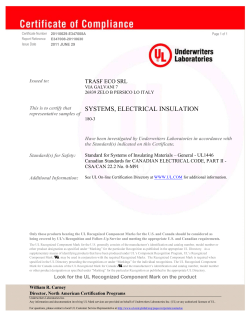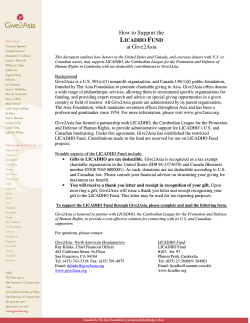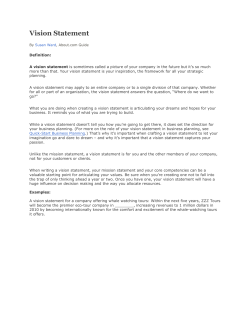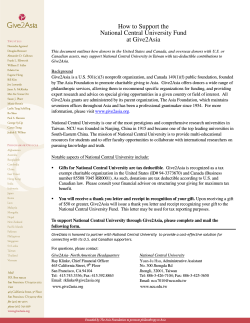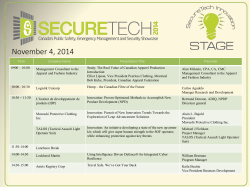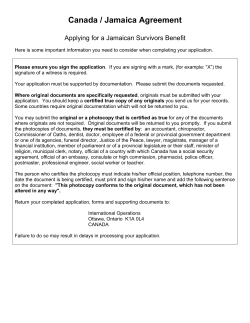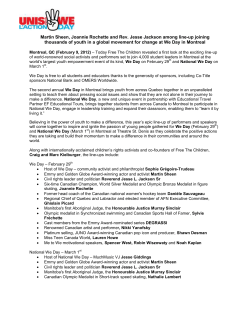
W
Canada’s Innovation Leaders, a RE$EARCH Infosource Inc. Publication November 7, 2014 Canadian Science Makes its Mark on the Global Stage Countries Put Faith in Global Partnerships to Solve Grand Scientific Challenges By Debbie Lawes W hat does a Canadian geneticist studying the behaviour of fruit flies have in common with an American doctor specializing in pediatrics? Both represent the new face of global science and perhaps our planet’s best hope for tackling some of the toughest challenges of our time, from climate change and energy security to infectious diseases and poverty. Earlier this year, Dr. Marla Sokolowski at the University of Toronto and Dr. Thomas Boyce at the University of California, along with colleagues in Canada, Illinois and Paris, published a pivotal series of studies showing how early experiences influence a child’s biology to increase the risks of poorer health later in life, learning difficulties and poor social functioning. It effectively put to rest the age-old debate over nature versus nurture. The studies may never have happened had the majority of the research team not been members of the Canadian Institute for Advanced Research. Headquartered in Toronto, CIFAR affords the world’s brightest thinkers the freedom to transcend national borders and scientific disciplines to collaborate on questions of importance to Canada and the world. CIFAR brings together some 400 scientists from 16 countries, including nearly twothirds from Canada. Over 40% of CIFAR Fellows are in the top 1% of their fields, and 15 Nobel Laureates have been associated with CIFAR since it was launched in 1982. “The rise of global research networks has become the modus operandi of so much science now. It’s about attracting the world’s best, not just the best in your own country,” says Dr. Alan Bernstein, president and CEO of CIFAR. “CIFAR builds on our domestic strengths to help position Canadian researchers and Canada in the middle of global research networks.” The global scientific landscape has changed dramatically in the last two decades. While international collaboration has always been integral to scholarly pursuits, scientific grand challenges, finite financial resources, ultra-fast communications networks, mass data storage and supercomputing have made it more imperative – and technically possible – to accelerate the scope and pace of international research. Today, about one-fifth of the world’s one million scientific papers are co-authored by researchers collaborating with international partners. More than 40% of academic publications by Canadians have co-authors from other countries – twice the rate of 15 years ago. Those numbers come as no surprise to Dr. Martin Osmond, CEO and scientific director of the Children’s Hospital of Eastern Ontario (CHEO) Research Institute in Ottawa, where the majority of its 160 researchers work with national and international partners. “Those collaborations are critical in pediatric research where many of the conditions we see are rare,” explains Osmond. “You need to work with other centres to have a sufficient number of patients to do (clinical) studies faster, get the results more quickly and because you’re already networked with people globally, it’s easier to get those results out into practice.” CHEO and Canada are recognized internationally for their expertise in many rare diseases, which collectively affect over 3.2 million Canadians, mostly children. The costs to treat these diseases with orphan drugs can easily exceed $500,000 annually for each patient, placing a heavy financial burden on both patients and provincial health budgets. In June, a pan-Canadian research team led by Dr. Kym Boycott at CHEO used powerful new gene sequencing technologies to examine 264 undiagnosed disorders. The results were impressive: the team uncovered the root genetic causes for 146 rare diseases. The Finding of Rare Disease Genes (FORGE Canada) project has now rolled into an international research program called CARE for RARE, also led by CHEO. The team hopes to identify even more rare disease genes, as well as design and test therapies in the lab to treat specific rare diseases. “The results of this study are already having a big impact on patients,” says Osmond. “Rather than undergoing months of tests – some very expensive – a simple blood test can now identify exactly what a child has, what the prognosis is and potential treatments.” Partnership funding on the rise The chair of Canada’s Science, Technology and Innovation Council (STIC), which advises the federal government, says Canada’s has always punched above its weight in terms of total number of scientific publications and citations. Government investment in publicly funded research also ranks near the top of OECD countries. The last few years have seen more of that funding go to international collaborations. “Several of the (research) granting councils have begun to invest more in international science and technology projects where Canada has a particular strength,” says Dr. Howard Alper. “For example, you have CIHR (Canadian Institutes of Health Research) investing with Japan in areas like epigenetics and with the EU on Alzheimer’s and neurodegenerative diseases.” There was a time not long ago, notes Alper, when Canada invested too little in international collaborations. “When I attended the G8 Carnegie Group (of international science leaders) a year ago, the European Commission representative noted that Canada had not been a major player in Europe, and then congratulated us on being the number one non-EU country involved in research collaborations with them.” Building on that momentum is the goal of Dr. Mario Pinto who is moving from Simon Fraser University this month to take over the top job at the Natural Sciences and Engineering Research Council in Ottawa. As NSERC’s new president, Pinto says there is no shortage of opportunities for Canadian researchers to partner internationally. What’s needed is the funding to make it happen. “That will be a key focus of NSERC’s new strategic plan. We must have skin in the game ... and on a scale where we can make a real contribution,” he says. Pinto spearheaded a strong global focus during his tenure as VP research at SFU, including a partnership with Tata Consultancy Services in India to pool R&D efforts in areas such as genomics and bioinformatics to track infectious and chronic diseases. Last year, SFU joined with Ryerson University to launch the first Canadian-led business accelerator in collaboration with India’s Bombay Stock Exchange. The incubator is home to about 40 Indian companies and will provide a soft landing pad for Canadian technology companies wanting to do business in one of the world’s fastest growing economies. SFU is also leveraging its expertise in hydrogen and fuel cell technology research to set up another joint venture in India, this one in partnership with Indian Oil Corporation. “We are their preferred partners to help them develop expertise in fuel cell science,” says Pinto. “The collaboration, which includes a partnership PhD program, will enable exchanges for SFU faculty and students to work in Indian Oil’s research facilities, while providing the company’s researchers access to SFU work.” Likewise, when Finnish-based telecommunications giant Nokia wanted to know more about its users’ music listening habits, it approached Dr. Matthew Woolhouse, a music cognition professor at the University of Cambridge in the U.K. Woolhouse has since moved to McMaster University where he opened a joint lab with Nokia last year to study the company’s massive database of music streaming and downloading records to understand how music affects people and shapes cultures. Woolhouse’s research is partly funded by the Social Sciences and Humanities Research Council (SSHRC), which has joined research funding agencies in Europe, Brazil, Mexico and the U.S. to create the Trans-Atlantic Platform. The consortium wants to make it easier for social sciences and humanities projects involving researchers from three or more countries to be funded, with minimal red tape and maximum impact. “Usually it’s a case where one researcher gets funded but their international partner doesn’t,” says Dr. Ted Hewitt, executive VP at SSHRC. “With this platform, we think we can develop mechanisms for one adjudication process and multiple funders. It’s about removing some of those barriers to collaboration.” Further west at the University of Calgary (U of C), the ink is still drying on a major joint venture with Kerui Group, a large oil and gas producer in China. Kerui built 4,000 square metres of lab space for U of C to collaborate with universities in Beijing and China’s state-owned enterprises on unconventional oil and gas (e.g. shale oil and gas and coalbed methane). The university’s VP research, Dr. Edward McCauley, calls it a natural partnership. “The University of Calgary is one of the world leaders in unconventional oil and gas research and minimizing the environmental impact associated with that. Anything we can do to help China move from coal to tapping their unconventional resources will have a dramatic impact on reducing their greenhouse gas emissions.” The rise of global research networks has “ become the modus operandi of so much science now. It’s about attracting the world’s best, not just the best in your own country. ” Dr. Alan Bernstein, President and CEO, Canadian Institute for Advanced Research One model for the platform is the Digging into Data Challenge, a competition to promote innovative research using large-scale data analysis. It represents a global first in research funding cooperation sponsored by SSHRC, NSERC, the Canada Foundation for Innovation and funding agencies in several countries. Rather than each researcher applying to every funder in their own country, international teams apply to just one competition. “This is a way to get more Canadian researchers more effectively and successfully engaged in international research that has impact,” says Hewitt. Hope for treating Ebola Another area where Canada is having a global impact is infectious diseases, the most recent example being the deadly Ebola virus. In August, two American medical workers infected with Ebola were treated with an experimental drug treatment developed a decade ago in Winnipeg at the Public Health Agency of Canada’s (PHAC) National Microbiology Lab in collaboration with the University of Manitoba (U of M). Today, the serum is being brought to market by a small U.S. company, in partnership with Toronto-based Defyrus Inc. Why did this discovery happen in Manitoba first? In addition to PHAC having one of the few level 4 biosafety labs in the world able to handle this highly infectious virus, U of M also has a 40-year track record in studying infectious diseases. “And we have a strong collaboration with scientists at the national microbiology lab, and with students working with researchers from both institutions,” says Dr. Digvir Jayas, the university’s VP research and international, adding that U of M recently received funding to establish a level 3 biosafety lab at the University of Nairobi in Kenya. The U of M is also a major contributor to Arctic and climate change research, attracting both investment and partners from countries such as Greenland, Iceland, Norway and Denmark. As a member of the ArcticNet Network of Centres of Excellence, U of M collaborates with 145 researchers from across Canada, as well as research teams from 12 countries to study the impacts of climate change, including melting sea ice. “Work done by Dave Barber (director of U of M’s Centre for Earth Observation Science and one of Canada’s top sea-ice experts) has shown how quickly the multi-year ice is evaporating, and the potential for it becoming open water through the year is becoming closer to reality,” says Jayas. U of C is making its mark in Qatar as well, building on the success of a nursing program established there in 2006 that trains 500 students each year. McCauley says the Qatar campus has elevated the profession of nursing throughout the Middle East and opened new windows for education, training and joint research in areas such as health care systems, child and maternal health and energy. Science under the sea One of world’s most impressive technological feats can be found off the coast of British Columbia. Managed by Ocean Networks Canada (ONC) at the University of Victoria, the NEPTUNE and VENUS observatories supply continuous power and Internet connectivity through marine cables to hundreds of sensors operating on the bottom of the ocean, throughout water columns and in bore holes drilled deep into the seafloor. Researchers control these instruments remotely and receive real-time data in their home laboratories, anywhere on the planet. ONC’s Innovation Centre (ONCIC) – one of Canada’s Centres of Excellence for Commercialization and Research – is working to turn this $200-million public investment into at least $270 million in new business for Canadian companies by 2021. ONCIC is targeting several countries that are either developing or expanding their undersea observatories, including Brazil, China, Korea and Australia. Opening Canadian labs to the world Canada’s strength in materials research is also attracting interest from international research organizations and companies. Xerox Research Centre of Canada (XRCC) recently signed a two-year deal to provide Battelle Memorial Institute of Columbus OH with access to its Mississauga ON research labs, including its 2500 square metre chemical pilot plant, as well as expertise in printable electronics and proven experience in moving advanced chemical processes from concept to market. Joining forces with the world’s largest contract research organization fits with XRCC’s strategy to open its labs to external researchers and companies. “There is a unique combination of valueadded private sector materials science R&D capability, engineering infrastructure and managerial expertise currently housed under the aegis of XRCC that is not replicated elsewhere in North America,” says Dr. Paul Smith, VP and director of XRCC. Founded in 1974, XRCC holds Xerox Corp.’s global mandate for materials research and in August was issued its 2000th patent for an invention that uses a super-thin and ultra-strong material called graphene for use in digital manufacturing. “Every core hardware product offered through the parent company’s sprawling global market channels contains technology that was invented and/or developed at the Canadian research centre,” says Smith. “It remains one of the little known, but enduring, Canadian innovation success stories driven by a proven ability to develop, attract and retain the world’s top research talent.” The other ingredients for success Globally competitive countries need excellent R&D and fortunately Canada ranks near the top of many international indicators. But even the best science won’t guarantee that a technology will be a global blockbuster. Business innovation and strategic collaborations are as critical as R&D, says Dr. Sorin Cohn, a strategic development executive at the Canadian Advanced Technology Alliance (CATA), which represents 600 member companies – 80% of which are exporters. “I’ve never seen a tech company die because they did not have a good product. They died because they focused too much on getting the perfect product, while forgetting to establish the capabilities for marketing and selling their products,” says Cohn. CATA’s has a few tips for small- and mid-sized companies looking to crack international markets. First, partner with large anchor companies – like a Bombardier or an IBM – with good reach into global markets. Even the best science won’t guarantee that a technology will be a global blockbuster. “Instead of just using NEPTUNE and VENUS for our own research, we’re taking these platforms global and allowing Canadian companies to use them as technology test beds,” says Dr. Kate Moran, ONC’s president and CEO. The test beds include remote sensor systems, observatory and digital infrastructure and data analytics that track everything from microbes and whales to earthquakes and tsunamis. It’s a one-stop shop approach that reduces the cost and time required to build new ocean monitoring systems. “The proposals we’re involved in mostly involve small- and medium-sized enterprises working together with our observatory knowhow to put together a robust proposal that no one else in the world can do,” says Moran. Also, don’t shy away from collaborating with other companies in your sector to create a cluster of expertise that strengthens your competitive position globally. Second, know the rules and the culture of the market you’re selling into and have boots on the ground there. And, most importantly, take advantage of free services offered by the Canadian government. “Companies don’t make enough use of our extensive network of trade commissioners overseas,” says Barry Gander, executive director at CATA. “They’re experts, they work hard and they can open doors for you.” Debbie Lawes (debbie@dovercourteditorial.ca) is an Ottawa-based science writer.
© Copyright 2025

